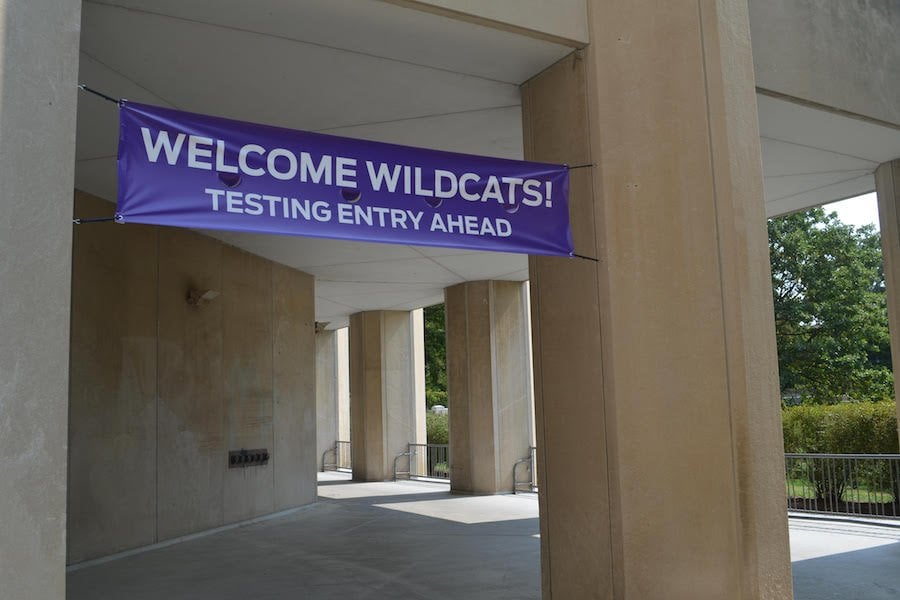Northwestern administers Color winter COVID-19 testing, students talk experiences
Daily file photo by Tal Schatsky
The Donald P. Jacobs Center, which has served as Northwestern’s main testing center. The University announced Color testing will resume through both the Jacobs Center and pick-up sites across campus.
January 11, 2021
The University has implemented a new testing system with the company Color in order to accommodate the influx of returning sophomores and new freshmen on campus. While some students have found it to be a relatively seamless process, others found some faults compared to Fall Quarter testing procedures.
Last quarter, NU provided testing to undergraduate students with partner company Tempus. Tempus utilizes RT-PCR techniques to amplify targeted genetic material, whereas Color’s testing uses RT-LAMP technology. RT-LAMP techniques maintain the same accuracy as RT-PCR procedures, but require fewer sophisticated instruments, increasing testing capacity. It can also generate amplified strands in less than an hour, showing to be faster and cheaper than its traditional PCR counterparts.
For the Winter Quarter, NU has partnered with Color to provide testing beginning in the Wildcat Wellness period. Prior to arriving on campus, students were expected to create a Color account. While on campus, students must continuously book their testing appointments to comply with the weekly testing requirement.
“I was really impressed when I first got on campus,” McCormick sophomore Olivia Johansson said. “I was surprised (by) how quickly (testing) went… they had a good flow going on and there wasn’t anywhere where I felt unsafe.”
While she felt safe taking off her mask in a big atrium, Johansson said she was concerned about performing the test quickly and correctly.
Having experienced testing both quarters, McCormick freshman Jasmyn Rieff said Color’s test relies on students to properly administer the test themselves. Last quarter, she said someone would demonstrate the Tempus testing procedure to a group of students as they completed it themselves.
However, Rieff worried the tests’ speed may come at the cost of reliability.
“I feel like it’s relying on the kids so much to be responsible for everything,” Rieff said. “I’m just kind of worried that it’s going to reduce the quality of some of the test results because there are kids who aren’t used to getting tested.”
Students are able to take the Color testing kit back to their dorm before returning it to the Donald P. Jacobs Center, which Rieff said could pose another risk in producing reliable results.
She was unable to get tested the day she arrived because of the lack of after-hours testing and said the instructions — all the way from the testing site entry to the actual administering of the test — were unclear.
Weinberg freshman Claire Paré said she was confused by the change in location between her first and second test.
“The first time I got my test it was in the middle of a giant lecture hall or auditorium and it was pretty clear where everything was,” Paré said. “But then the second time it was in a basement. I couldn’t really follow where they wanted me to go and I got lost a couple times.”
While she found the testing center’s layout unclear, Paré said she was surprised by how simple and efficient it is to test with Color. Compared to testing with Tempus, Color reduces the number of steps the user performs with the swab. After the student rotates the swab three times in each nostril, a Color test prompts the user to then insert the cotton tip down into the tube while a Tempus test requires the user to properly transfer the sample into a solution for thirty seconds.
Not only has the University sought to scale up the number of tests it can administer at once by partnering with Color, but it has also continued some of its more successful testing practices from last quarter to accommodate more students in the winter.
“I’m glad (the testing center is) in a central location,” Johansson said. “It’s not in South Campus, it’s not really in North Campus, it’s right in the middle so it’s accessible to anyone.”
Email: amittal@u.northwestern.edu
Twitter: @amittal27
Related Stories:
— Amid rising cases, Northwestern announces weekly COVID-19 testing of students allowed on campus
— Northwestern announces “Wildcat Wellness” guidelines, new COVID-19 testing partnership with Color



